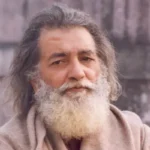Born in the small town of Dhuri, Manjit Bawa’s works seem to inhabit the interstitial spaces between mythology, nature, and Sufi philosophy. Although he studied under professors Somnath Hore, Rakesh Mehra, Dhanaraj Bhagat, and B.C. Sanyal, it was under the tutelage of Abani Sen when he truly came into his own. Sen urged Bawa to sketch his surroundings ceaselessly, leading Bawa to lean towards a figurative style, which was uncommon for his time. He learned the intricacies of the narrative form only to distort it, breaking open countless metaphorical possibilities.
From 1964 to 1971, Bawa worked as a silkscreen printer in Britain whilst pursuing his studies. Yet he retained distinctly Indian motifs, emerging from mythology and Sufi poetry. He drew from the stories of his childhood, be it Mahabharat, Ramayan, the Puranas, or the poetry of Waris Shah.
One of the first painters to adopt a vibrant colour palette, Bawa took conscious inspiration from nature. Animals, too, make a constant appearance in his works, as the artist evokes the Sufi idea of co-existence of all living beings. Bawa trained under flute maestro Pannalal Ghosh, translating this experience into a rhythmic musicality in his works. The flute is a recurring motif in his works as well, often encoded with symbolism.
Bawa studied at the College of Art, New Delhi and later at the London School of Printing. In his career spanning four decades, he had over 25 solo shows in various cities around the world including London, Hong Kong, Washington, New Delhi, Mumbai, and Chennai. Bawa’s work has been shown various at prestigious venues including National Gallery of Modern Art (NGMA), New Delhi; Royal Academy, London; and Hirschorn Museum, Washington. A film on the artist directed by Buddadeb Dasgupta titled ‘Meeting Manjit’, received the National Award for Best Documentary in 2002.
Bawa passed away in 2008.
From 1964 to 1971, Bawa worked as a silkscreen printer in Britain whilst pursuing his studies. Yet he retained distinctly Indian motifs, emerging from mythology and Sufi poetry. He drew from the stories of his childhood, be it Mahabharat, Ramayan, the Puranas, or the poetry of Waris Shah.
One of the first painters to adopt a vibrant colour palette, Bawa took conscious inspiration from nature. Animals, too, make a constant appearance in his works, as the artist evokes the Sufi idea of co-existence of all living beings. Bawa trained under flute maestro Pannalal Ghosh, translating this experience into a rhythmic musicality in his works. The flute is a recurring motif in his works as well, often encoded with symbolism.
Bawa studied at the College of Art, New Delhi and later at the London School of Printing. In his career spanning four decades, he had over 25 solo shows in various cities around the world including London, Hong Kong, Washington, New Delhi, Mumbai, and Chennai. Bawa’s work has been shown various at prestigious venues including National Gallery of Modern Art (NGMA), New Delhi; Royal Academy, London; and Hirschorn Museum, Washington. A film on the artist directed by Buddadeb Dasgupta titled ‘Meeting Manjit’, received the National Award for Best Documentary in 2002.
Bawa passed away in 2008.

 Back
Back










